traction control CHEVROLET COBALT 2007 1.G User Guide
[x] Cancel search | Manufacturer: CHEVROLET, Model Year: 2007, Model line: COBALT, Model: CHEVROLET COBALT 2007 1.GPages: 450, PDF Size: 2.48 MB
Page 236 of 450
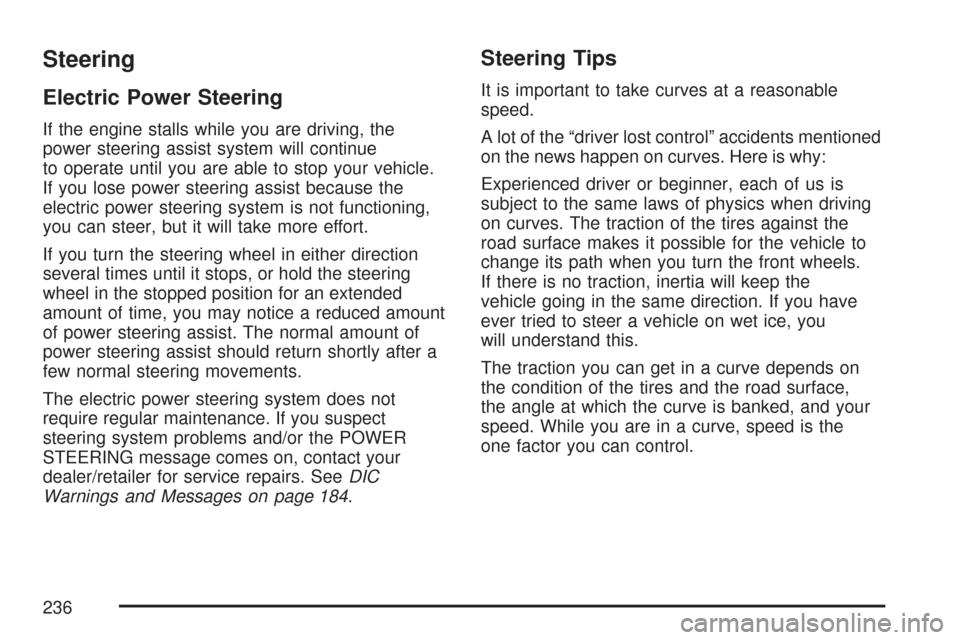
Steering
Electric Power Steering
If the engine stalls while you are driving, the
power steering assist system will continue
to operate until you are able to stop your vehicle.
If you lose power steering assist because the
electric power steering system is not functioning,
you can steer, but it will take more effort.
If you turn the steering wheel in either direction
several times until it stops, or hold the steering
wheel in the stopped position for an extended
amount of time, you may notice a reduced amount
of power steering assist. The normal amount of
power steering assist should return shortly after a
few normal steering movements.
The electric power steering system does not
require regular maintenance. If you suspect
steering system problems and/or the POWER
STEERING message comes on, contact your
dealer/retailer for service repairs. SeeDIC
Warnings and Messages on page 184.
Steering Tips
It is important to take curves at a reasonable
speed.
A lot of the “driver lost control” accidents mentioned
on the news happen on curves. Here is why:
Experienced driver or beginner, each of us is
subject to the same laws of physics when driving
on curves. The traction of the tires against the
road surface makes it possible for the vehicle to
change its path when you turn the front wheels.
If there is no traction, inertia will keep the
vehicle going in the same direction. If you have
ever tried to steer a vehicle on wet ice, you
will understand this.
The traction you can get in a curve depends on
the condition of the tires and the road surface,
the angle at which the curve is banked, and your
speed. While you are in a curve, speed is the
one factor you can control.
236
Page 237 of 450
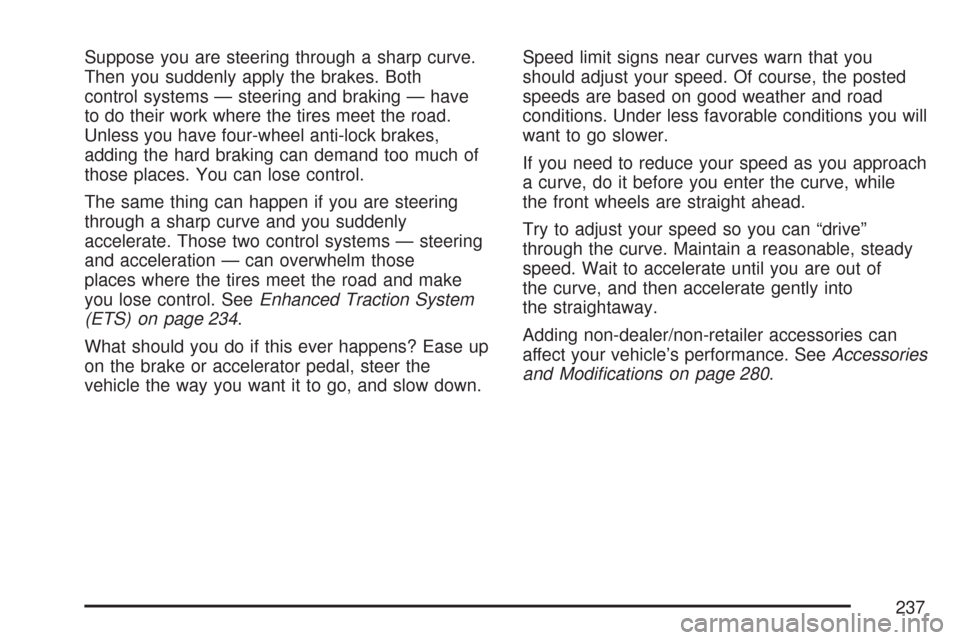
Suppose you are steering through a sharp curve.
Then you suddenly apply the brakes. Both
control systems — steering and braking — have
to do their work where the tires meet the road.
Unless you have four-wheel anti-lock brakes,
adding the hard braking can demand too much of
those places. You can lose control.
The same thing can happen if you are steering
through a sharp curve and you suddenly
accelerate. Those two control systems — steering
and acceleration — can overwhelm those
places where the tires meet the road and make
you lose control. SeeEnhanced Traction System
(ETS) on page 234.
What should you do if this ever happens? Ease up
on the brake or accelerator pedal, steer the
vehicle the way you want it to go, and slow down.Speed limit signs near curves warn that you
should adjust your speed. Of course, the posted
speeds are based on good weather and road
conditions. Under less favorable conditions you will
want to go slower.
If you need to reduce your speed as you approach
a curve, do it before you enter the curve, while
the front wheels are straight ahead.
Try to adjust your speed so you can “drive”
through the curve. Maintain a reasonable, steady
speed. Wait to accelerate until you are out of
the curve, and then accelerate gently into
the straightaway.
Adding non-dealer/non-retailer accessories can
affect your vehicle’s performance. SeeAccessories
and Modi�cations on page 280.
237
Page 242 of 450

If you have the Enhanced Traction System (ETS),
remember: It helps to avoid only the acceleration
skid. SeeEnhanced Traction System (ETS)
on page 234. If you do not have the Enhanced
Traction System, or if the system is off, then
an acceleration skid is also best handled by
easing your foot off the accelerator pedal.
If your vehicle starts to slide, ease your foot off the
accelerator pedal and quickly steer the way you
want the vehicle to go. If you start steering quickly
enough, your vehicle may straighten out. Always be
ready for a second skid if it occurs.
Of course, traction is reduced when water, snow,
ice, gravel, or other material is on the road.
For safety, you will want to slow down and adjust
your driving to these conditions. It is important
to slow down on slippery surfaces because
stopping distance will be longer and vehicle control
more limited.
While driving on a surface with reduced traction,
try your best to avoid sudden steering,
acceleration, or braking, including reducing
vehicle speed by shifting to a lower gear. Any
sudden changes could cause the tires to slide.You may not realize the surface is slippery until
your vehicle is skidding. Learn to recognize
warning clues — such as enough water, ice, or
packed snow on the road to make a mirrored
surface — and slow down when you have
any doubt.
If you have the Anti-Lock Brake System (ABS),
remember: It helps avoid only the braking skid.
If you do not have ABS, then in a braking
skid, where the wheels are no longer rolling,
release enough pressure on the brakes to get the
wheels rolling again. This restores steering
control. Push the brake pedal down steadily when
you have to stop suddenly. As long as the
wheels are rolling, you will have steering control.
Racing or Other Competitive Driving
See your warranty book before using your vehicle
for racing or other competitive driving. After
reviewing your warranty book, please see the
GM Performance Parts website or catalog
and contact the race sanctioning bodies, for
example Sports Car Club of America (SCCA) or
Grand American, for parts and equipment required
for racing or other competitive driving.
242
Page 280 of 450

Service
Your dealer knows your vehicle best and wants
you to be happy with it. We hope you will go to
your dealer for all your service needs. You will get
genuine GM parts and GM-trained and supported
service people.
We hope you will want to keep your GM vehicle all
GM. Genuine GM parts have one of these marks:
Accessories and Modi�cations
When you add non-GM accessories to your vehicle
they can affect your vehicle’s performance and
safety, including such things as, airbags, braking,
stability, ride and handling, emissions systems,
aerodynamics, durability, and electronic systems
like anti-lock brakes, traction control and stability
control. Some of these accessories may even
cause malfunction or damage not covered by
warranty.
GM Accessories are designed to complement
and function with other systems on your vehicle.
Your GM dealer/retailer can accessorize your
vehicle using genuine GM Accessories. When
you go to your GM dealer/retailer and ask for
GM Accessories, you will know that GM-trained
and supported service technicians will perform
the work using genuine GM Accessories.
280
Page 351 of 450

When It Is Time for New Tires
One way to tell when it
is time for new tires is
to check the treadwear
indicators, which will
appear when your tires
have only 1/16 inch
(1.6 mm) or less of
tread remaining.
You need a new tire if any of the following
statements are true:
You can see the indicators at three or more
places around the tire.
You can see cord or fabric showing through
the tire’s rubber.
The tread or sidewall is cracked, cut, or
snagged deep enough to show cord or fabric.
The tire has a bump, bulge, or split.
The tire has a puncture, cut, or other damage
that cannot be repaired well because of the
size or location of the damage.
Buying New Tires
GM has developed and matched speci�c tires for
your vehicle. The original equipment tires installed
on your vehicle, when it was new, were designed to
meet General Motors Tire Performance Criteria
Speci�cation (TPC spec) system rating. If you need
replacement tires, GM strongly recommends that
you get tires with the same TPC Spec rating. This
way, your vehicle will continue to have tires that are
designed to give the same performance and vehicle
safety, during normal use, as the original tires.
GM’s exclusive TPC Spec system considers over
a dozen critical speci�cations that impact the
overall performance of your vehicle, including
brake system performance, ride and handling,
traction control, and tire pressure monitoring
performance. GM’s TPC Spec number is molded
onto the tire’s sidewall by the tire manufacturer.
If the tires have an all-season tread design,
the TPC spec number is followed by an MS
for mud and snow. SeeTire Sidewall Labeling
on page 340for additional information.
351
Page 353 of 450
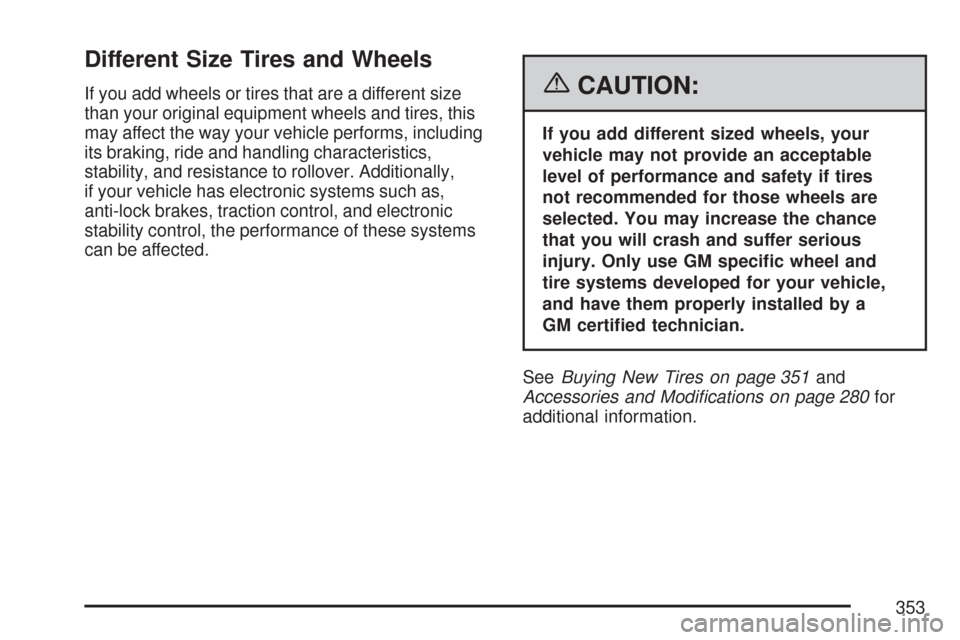
Different Size Tires and Wheels
If you add wheels or tires that are a different size
than your original equipment wheels and tires, this
may affect the way your vehicle performs, including
its braking, ride and handling characteristics,
stability, and resistance to rollover. Additionally,
if your vehicle has electronic systems such as,
anti-lock brakes, traction control, and electronic
stability control, the performance of these systems
can be affected.{CAUTION:
If you add different sized wheels, your
vehicle may not provide an acceptable
level of performance and safety if tires
not recommended for those wheels are
selected. You may increase the chance
that you will crash and suffer serious
injury. Only use GM speci�c wheel and
tire systems developed for your vehicle,
and have them properly installed by a
GM certi�ed technician.
SeeBuying New Tires on page 351and
Accessories and Modi�cations on page 280for
additional information.
353
Page 354 of 450
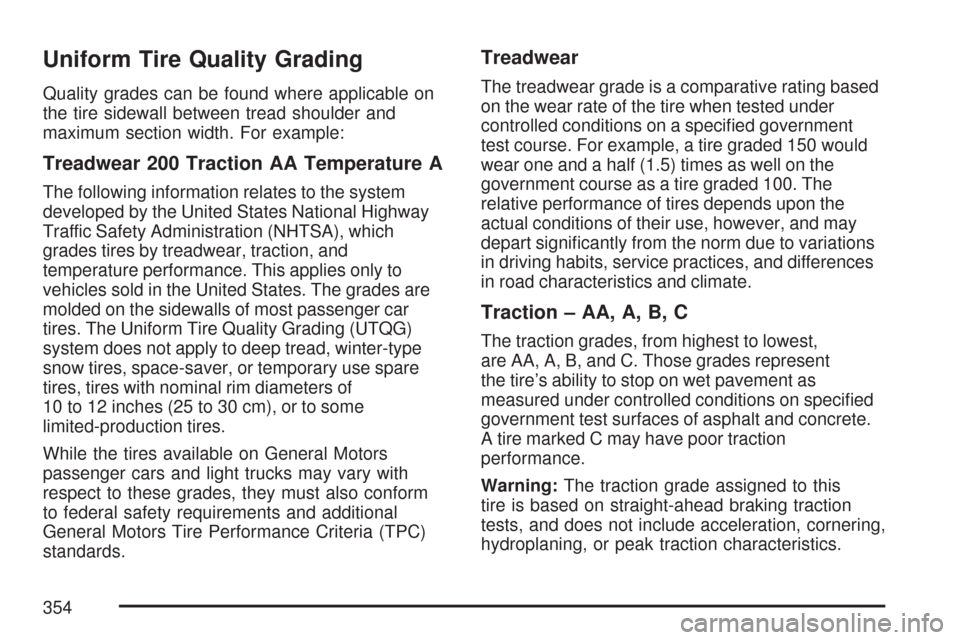
Uniform Tire Quality Grading
Quality grades can be found where applicable on
the tire sidewall between tread shoulder and
maximum section width. For example:
Treadwear 200 Traction AA Temperature A
The following information relates to the system
developed by the United States National Highway
Traffic Safety Administration (NHTSA), which
grades tires by treadwear, traction, and
temperature performance. This applies only to
vehicles sold in the United States. The grades are
molded on the sidewalls of most passenger car
tires. The Uniform Tire Quality Grading (UTQG)
system does not apply to deep tread, winter-type
snow tires, space-saver, or temporary use spare
tires, tires with nominal rim diameters of
10 to 12 inches (25 to 30 cm), or to some
limited-production tires.
While the tires available on General Motors
passenger cars and light trucks may vary with
respect to these grades, they must also conform
to federal safety requirements and additional
General Motors Tire Performance Criteria (TPC)
standards.
Treadwear
The treadwear grade is a comparative rating based
on the wear rate of the tire when tested under
controlled conditions on a speci�ed government
test course. For example, a tire graded 150 would
wear one and a half (1.5) times as well on the
government course as a tire graded 100. The
relative performance of tires depends upon the
actual conditions of their use, however, and may
depart signi�cantly from the norm due to variations
in driving habits, service practices, and differences
in road characteristics and climate.
Traction – AA, A, B, C
The traction grades, from highest to lowest,
are AA, A, B, and C. Those grades represent
the tire’s ability to stop on wet pavement as
measured under controlled conditions on speci�ed
government test surfaces of asphalt and concrete.
A tire marked C may have poor traction
performance.
Warning:The traction grade assigned to this
tire is based on straight-ahead braking traction
tests, and does not include acceleration, cornering,
hydroplaning, or peak traction characteristics.
354
Page 357 of 450
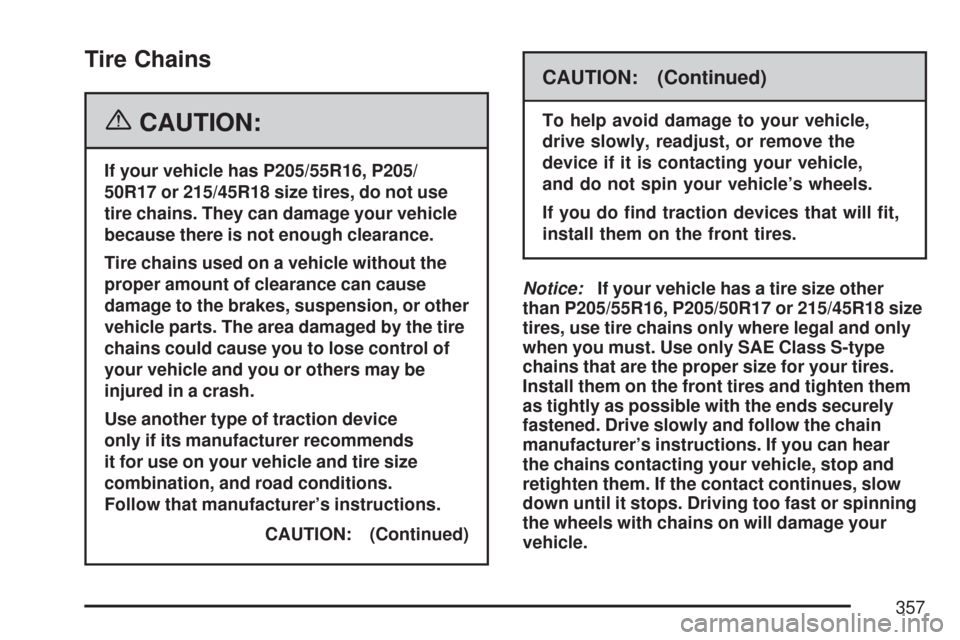
Tire Chains
{CAUTION:
If your vehicle has P205/55R16, P205/
50R17 or 215/45R18 size tires, do not use
tire chains. They can damage your vehicle
because there is not enough clearance.
Tire chains used on a vehicle without the
proper amount of clearance can cause
damage to the brakes, suspension, or other
vehicle parts. The area damaged by the tire
chains could cause you to lose control of
your vehicle and you or others may be
injured in a crash.
Use another type of traction device
only if its manufacturer recommends
it for use on your vehicle and tire size
combination, and road conditions.
Follow that manufacturer’s instructions.
CAUTION: (Continued)
CAUTION: (Continued)
To help avoid damage to your vehicle,
drive slowly, readjust, or remove the
device if it is contacting your vehicle,
and do not spin your vehicle’s wheels.
If you do �nd traction devices that will �t,
install them on the front tires.
Notice:If your vehicle has a tire size other
than P205/55R16, P205/50R17 or 215/45R18 size
tires, use tire chains only where legal and only
when you must. Use only SAE Class S-type
chains that are the proper size for your tires.
Install them on the front tires and tighten them
as tightly as possible with the ends securely
fastened. Drive slowly and follow the chain
manufacturer’s instructions. If you can hear
the chains contacting your vehicle, stop and
retighten them. If the contact continues, slow
down until it stops. Driving too fast or spinning
the wheels with chains on will damage your
vehicle.
357
Page 442 of 450

L
Labeling, Tire Sidewall................................. 340
Lamps
Dome....................................................... 155
Mirror Reading......................................... 155
LATCH System
Child Restraints......................................... 53
License Plate Lamps................................... 336
Light
Airbag Readiness..................................... 167
Anti-Lock Brake System Warning............. 172
Brake System Warning............................. 171
Charging System..................................... 170
Engine Coolant Temperature Warning....... 174
Enhanced Traction System (ETS)
Warning Light....................................... 173
Fog Lamp................................................ 179
Highbeam On.......................................... 179
Malfunction Indicator................................ 174
Oil Pressure............................................. 178
Passenger Airbag Status Indicator............ 168
Passenger Safety Belt Reminder.............. 167
Safety Belt Reminder............................... 166Light (cont.)
Security................................................... 179
Up-Shift................................................... 171
Lighting
Entry/Exit................................................. 155
Lights.......................................................... 152
Flash-to-Pass........................................... 146
High/Low Beam Changer ......................... 146
On Reminder........................................... 153
Limited-Slip Differential................................ 235
Loading Your Vehicle................................... 259
Lockout Protection....................................... 101
Locks
Automatic Door Lock................................ 100
Delayed Locking........................................ 99
Door.......................................................... 98
Lockout Protection................................... 101
Power Door............................................... 99
Programmable Automatic Door Unlock..... 100
Rear Door Security Locks........................ 100
Loss of Control........................................... 241
Lumbar
Manual Controls......................................... 10
442